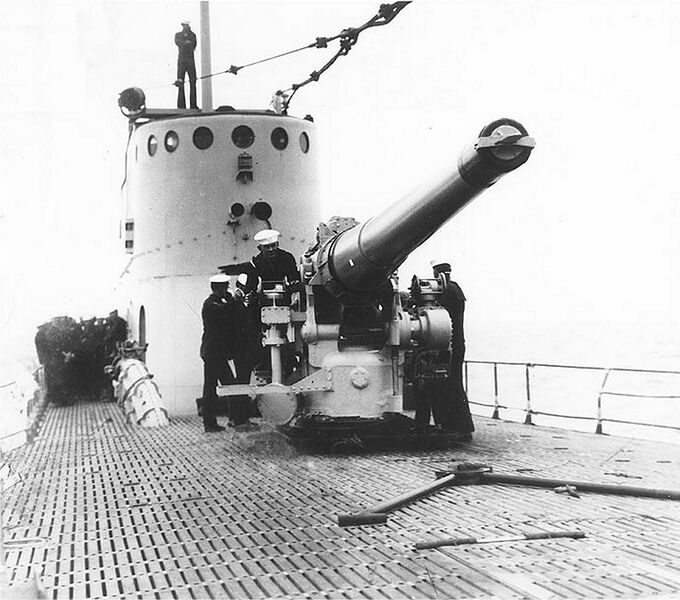V-4: Difference between revisions
Pbcjohnston (talk | contribs) Formatted photos |
Pbcjohnston (talk | contribs) →Sea trials, June, 1928: Added video |
||
| (63 intermediate revisions by 2 users not shown) | |||
| Line 1: | Line 1: | ||
[[File:Header | {{#seo:|title=submarine USS V-4 Argonaut (SM-1/SS-166) - PigBoats.COM submarine|title_mode=replace}} | ||
{{#seo:|description=Photographs and pictures of the submarine USS V-4 Argonaut (SM-1/SS-166)}} | |||
[[File:New Header 1 Argonaut.jpg]] | |||
=== <big>Design, Construction, and Naming Notes</big> === | === <big>Design, Construction, and Naming Notes</big> === | ||
<div style="text-align: justify;"><span style="color:#00008B">During WWI the Imperial German Navy had used specially built minelaying submarines to great effect. If your enemy did not know the minefield was present, it was all the more effective at sinking ships. Submarine Force advocates strongly lobbied the Navy's General Board to get them to include a specialized minelayer into what was becoming the experimental V-class. With the first three boats becoming prototype fleet submarines, V-4 became the minelayer, although her design ended up being a hybrid of long-range anti-commerce cruiser and minelayer. | <div style="text-align: justify;"><span style="color:#00008B">During WWI the Imperial German Navy had used specially built minelaying submarines to great effect. If your enemy did not know the minefield was present, it was all the more effective at sinking ships. Submarine Force advocates strongly lobbied the Navy's General Board to get them to include a specialized minelayer into what was becoming the experimental V-class. With the first three boats becoming prototype fleet submarines, V-4 became the minelayer, although her design ended up being a hybrid of long-range anti-commerce cruiser and minelayer. | ||
V-4 was a giant. At 381 feet long and a displacement of 3,046 tons submerged her size would not be exceeded by a USN submarine until the nuclear-powered USS Triton (SSRN-586) of 1955. Her great size was dictated by the need to achieve long range. Only a very large submarine would be able to carry the fuel necessary to span the Atlantic and Pacific in search of the enemy's merchantmen. V-4 was also to be equipped with the largest caliber gun ever installed on a USN submarine, two 6"/53 caliber Mk 17 guns, one forward and one aft of the conning tower fairwater in open mounts. | V-4 was a giant. At 381 feet long and a displacement of 3,046 tons submerged her size would not be exceeded by a USN submarine until the nuclear-powered USS Triton (SSRN-586) of 1955. Her great size was dictated by the need to achieve long range. Only a very large submarine would be able to carry the fuel necessary to span the Atlantic and Pacific in search of the enemy's merchantmen. V-4 was also to be equipped with the largest caliber gun ever installed on a USN submarine, two 6"/53 caliber Mk 17 Mod 1 guns, one forward and one aft of the conning tower fairwater in open mounts. | ||
Her great range enabled V-4 to go to an enemy's coastline and lay an effective minefield. The minelaying gear was unique to the boat, and it occupied the after end. Space was provided for sixty huge [http://www.navweaps.com/Weapons/WAMUS_Mines.php#Mark_11 '''Mk 11 mines'''] and innovative, automatic, hydraulically operated handling gear. The mines were stowed in large rotating cylinders, similar in appearance to the cylinder in a revolver handgun. The cylinders would rotate to line up with the 40 inch diameter launching tubes, and the mines moved into the tubes by the loading gear. The tubes would be flooded and the mines were pushed out, dropping astern as the boat moved. This entire sequence could be conducted while the boat was completely submerged. She also was equipped with four 21-inch torpedo tubes forward, with a capacity of 20 Mk 14 torpedoes. | |||
During the construction of V-4, the Navy began to experiment with welding. This new and as-yet unproven process was used in certain non-critical areas like superstructure framing, pipe brackets, and interior deck joinery. The remainder of her construction was traditional riveting. The Navy's attitude towards this potential paradigm shift in submarine construction remained rather tepid for the next six years as they gained confidence in this radical change, and as they worked out labor and organizational issues. Please read [https://pigboats.icci.llc/images/3/37/NO_MORE_HEADS_OR_TAILS_TSR_version.pdf '''this article'''] that deals with this important subject. | |||
All of the V-boats, but especially the huge V-4, suffered from an underdeveloped diesel engine industrial base in the United States. The industry was still in its infancy in the U.S., and the Navy was forced to rely on license-built derivations of German MAN company designs. The V-4 was definitely underpowered, with her plant consisting of two direct drive 1,400 hp BuEng/MAN 6A20⅞-R main propulsion diesels, and one 450 hp BuEng/MAN 6A13¾-N generator engine. The Navy specified 15 knots for this boat, and she struggled to make that. | |||
Once commissioned the Navy got a chance to try her out. The minelaying gear proved to be finicky and difficult to maintain and the minelaying role was ultimately unpopular with the force. V-4 was a slow diver with sluggish underwater maneuverability and her engines were not reliable. Despite this, the boat provided good service to the fleet during the 1930's. On February 19, 1931 she was renamed Argonaut. Noted historian John D. Alden maintains that she was never officially redesignated into the general SS series (her hull number would have been 166), and has stated that she remained designated SM-1 until September 22, 1942. However, the authors have uncovered photos of her from the late 1930's that show her with 166 painted on the side of her fairwater. This would not have been done without official approval, and therefore the official redesignation is actually true. It is possible that the otherwise meticulous Alden simply missed the document concerning her redesignation during his research, or it had been destroyed or lost and was not available to him. | |||
By the start of the war she was worn out and in need of a thorough overhaul. An early 1942 yard period at Mare Island completely reconditioned the boat, giving her new General Motors 12-258S engines, air conditioning, a torpedo data computer, radar, longer periscopes, and two aft facing topside torpedo tubes. At that time it was felt that she could still prove useful as a minelayer so her aft minelaying gear was retained. She arrived back in Pearl Harbor in early August just in time to be assigned to the [[Makin Island Raid|'''Makin Island raid''']], where it was realized her great size would enable her to carry dozens of Marines. The Pearl Harbor Navy Yard hurriedly stripped most of the mine handling gear from the after rooms and installed numerous bunks for the Marines. This capability gave her a new lease on life and on September 22, 1942 she was redesignated APS-1 (Auxiliary Transport Submarine) to reflect this new mission. | |||
The needs of the war effort forced the Navy to send her on general patrol duties, where her great size and barge-like maneuverability placed her at a disadvantage when dealing with the nimble Japanese destroyers. She made several war patrols before being caught by an IJN anti-submarine force off New Britain. She was sunk in battle in a combined depth charge and gunnery attack. 105 officers and men remain on eternal patrol. | |||
Note: At the start of the war, the Navy had approximately 200 Mk 11 mines in their inventory, mines that had been specifically designed for this boat. Argonaut never laid a minefield in wartime, and what became of the unique Mk 11 mines is not known at this time. See [http://www.navweaps.com/Weapons/WAMUS_Mines.php '''this page'''] for more information on this subject.</span></div> | |||
[[File:Red bar sub new 2.jpg]] | [[File:Red bar sub new 2.jpg]] | ||
<div style="text-align: justify;"><span style="color:#000000"> | |||
=== Launch, fitting out, and commissioning, Portsmouth Navy Yard, 1927-1928 === | |||
</div><br> | |||
[[File:Argonaut launch 1.jpg|left|500px]] | [[File:Argonaut launch 1.jpg|left|500px]] | ||
<div style="text-align: justify;"><span style="color:#00008B">V-4 (SM-1) about ready to launch, aproximately November 6, 1927. The yard has yet to 'dress ship' for the occasion, meaning draping the signal flags from the top of the periscope to the bow and stern and hoisting the Union Jack and American Flag. She was launched on November 10, 1927, probably a few days away, at Portsmouth Navy Yard, Kittery, Maine. V-4 was the USN's only purpose-built minelaying submarine, and was the largest submarine built for the USN until the nuclear powered USS Triton (SSRN-586) of 1959. | <div style="text-align: justify;"><span style="color:#00008B">V-4 (SM-1) about ready to launch, aproximately November 6, 1927. The yard has yet to 'dress ship' for the occasion, meaning draping the signal flags from the top of the periscope to the bow and stern and hoisting the Union Jack and American Flag. She was launched on November 10, 1927, probably a few days away, at Portsmouth Navy Yard, Kittery, Maine. V-4 was the USN's only purpose-built minelaying submarine, and was the largest submarine built for the USN until the nuclear powered USS Triton (SSRN-586) of 1959. | ||
<small>U.S. Navy photo</small> | <small>U.S. Navy photo</small> | ||
| Line 65: | Line 76: | ||
[[File:Red bar sub new 2.jpg]] | [[File:Red bar sub new 2.jpg]] | ||
[[File:Argonaut Ports dd 1.jpg|left|500px]] | |||
<div style="text-align: justify;"><span style="color:#00008B">V-4 and the USS [[O-2|'''O-2 (SS-63)''']] in dry dock together, March 29, 1928. V-4 has not yet been commissioned, and was put into the dock for needed work prior to delivery. The dock is being flooded through ports in the dry dock gates at the rear of the image. The V-4 at that time was the largest submarine in the world at 381 feet long and the O-2 had a length of 172 feet, 209 feet shorter than the V-4! The rapid advance in submarine technology in just ten years is nothing short of amazing. | |||
<small>U.S. Navy photo</small> | |||
[[File:Red bar sub new 2.jpg]] | |||
[[File:Argonaut Ports dd 2.jpg|left|500px]] | |||
<div style="text-align: justify;"><span style="color:#00008B">V-4 precommissioning drydocking, March 29, 1928. The dock has been flooded, the caisson removed, and V-4 is about to exit the dry dock. O-2 has already been pulled out to go back to her mooring. V-4's number one torpedo tube outer door can be just above the waterline. It looks like V-4's periscopes have not yet been installed. | |||
<small>U.S. Navy photo</small> | |||
[[File:Red bar sub new 2.jpg]] | |||
[[File:Argonaut comm day 1.jpg|left|500px]] | |||
<div style="text-align: justify;"><span style="color:#00008B">April 2, 1928, Portsmouth Navy Yard, Kittery, ME. V-4 has been completed and the yard is ready to turn her over to the Navy. The crew and distinguished guest have been assembled on the aft deck, a Navy band is in place, and the National Ensign and the Union Jack is raised for the first time from the flag and jack staffs. The officer in the center slauting is likely LCDR William M. Quigley, the Commanding Officer. He has just read the orders from the Navy Department placing the ship in commission. | |||
<small>U.S. Navy photo</small> | |||
[[File:Red bar sub new 2.jpg]] | |||
[[File:Argonaut comm day 2.jpg|left|500px]] | |||
<div style="text-align: justify;"><span style="color:#00008B">This photo was taken just a few moments after the one above, showing the commissioning ceremony for the USS V-4 on April 2, 1928. The sailor at the flagstaff on the stern is now saluting. At least two motion picture men have moved their cameras into place to get good shots of the ceremony. | |||
The notch in the edge of the deck on the starboard side was for a communications mast that would fold down into the notch. The mast is not yet installed in this photo. There is a similar notch for another mast in the edge of the deck forward of the forward deck gun. | |||
<small>U.S. Navy photo</small> | |||
[[File:Red bar sub new 2.jpg]] | |||
[[File:Argonaut precom 1.jpg|left|500px]] | |||
<div style="text-align: justify;"><span style="color:#00008B">V-4 at Portsmouth, shortly after her commissioning, approximately spring 1928. There appears to be a large vertical tube mounted in the after deck. This looks to be the exhaust stack from the boat's heating boiler mounted in the aft end of the engine room. This is seen in line drawings but never seen in photographs before. Behind this "exhaust duct" can be seen the after 6"/53 caliber deck gun. | |||
<small>Photo in the private collection of Ric Hedman</small> | |||
[[File:Red bar sub new 2.jpg]] | |||
[[File:Argonaut precom 2.jpg|left|500px]] | |||
<div style="text-align: justify;"><span style="color:#00008B">Probably the most prominent feature in this close up is the brace-like structure built to support the aft ends of the long wire radio antennas. Radio was barely 25 years old as a technology and improvements were being worked on all the time. Note also the open hatch to the mine room.</span></div> | |||
<small>Photo in the private collection of Ric Hedman</small> | |||
[[File:Red bar sub new 2.jpg]] | |||
<div style="text-align: justify;"><span style="color:#000000"> | |||
=== Sea trials, June, 1928 === | |||
</div><br> | |||
<center> | |||
<gallery mode="packed" widths="500px" heights="400px"> | |||
File:Argonaut gun 1.jpg | |||
File:Argonaut gun 2.jpg | |||
</gallery> | |||
</center> | |||
<div style="text-align: justify;"><span style="color:#00008B">Two views of V-4's foreward 6"/53 caliber Mk 18 Mod 1 gun. The ammunition hoist for sending the 6" projectile and powder bag up to the deck can be seen sticking out of the deck to the left. The barrel tampion can be seen in the barrel muzzle and the brace for supporting the end of the barrel is lying flat on the deck. The luggage seen against the conning tower are probably equipment cases for the photographers and film crews along for the ride. Dates for these photos are approximately June, 1926.<br><br> | |||
<center><small>U.S. Navy photos</small></center> | |||
[[File:Red bar sub new 2.jpg]] | |||
{{#ev:youtube|id=9NAxgaGrbn8|alignment=left|dimensions=500x300}} | |||
V-4 making a dive likely sometime in 1928 during trials. The long low shoreline in the background indicates that this is Cape Cod Bay, Massachusetts. That would put this video in the same time frame as the rest of the photos in this section. | |||
<small>Video from the YouTube British Pathé channel.</small> | |||
[[File:Red bar sub new 2.jpg]] | |||
[[File:Argonaut dive 1A.jpg|left|500px]] | |||
<div style="text-align: justify;"><span style="color:#00008B">V-4 begins a trial dive on June 21, 1928 off Provincetown, Massachusetts on the measured mile submarine course laid out just off the town in Cape Cod Bay. The following sequence shows the progress of her dive over the course of about one minute, followed by a series of her returning to the surface. | |||
Her gun deck with her two 6"/53 caliber guns is just awash and the conning tower fairwater accesses are filling with water. The little splash of water seen just to the right of the forward fairwater access is coming from the ammunition hoist as it goes under water. | |||
The short periscope at the front of the conning tower is the #1 periscope. It is offset to starboard by four feet off the center line (note its location in subsequent photos below) and is a short 'scope to be used before surfacing to check for obstacles. This periscope was later removed as unnecessary. The submarine had two centerline mounted regular periscopes that gave full visibility. These periscopes were all raised by electric motors and used a chain drive like a motorcycle type chain. They were very noisy. If you get a chance to see the 1931 movie "Seas Beneath" you can see and hear them in operation plus see some interior images of the submarine. | |||
The ship's whistle can be seen sticking out at the front of the fairwater midway between the step and the top. | |||
<small>Photo in the private collection of Ric Hedman.</small> | |||
[[File:Red bar sub new 2.jpg]] | |||
[[File:Argonaut dive 1.jpg|left|500px]] | |||
<div style="text-align: justify;"><span style="color:#00008B">V-4 is now a little deeper in the water. Notice that even at full extension the #1 scope barely cleared the antenna wires and the support brackets on the bridge. This periscope would not have been used at periscope depth as the boat would have to nearly broach the top of the fairwater to get the head above the waves. As stated before it was used to search the surface for obstacles as the boat came to periscope depth, and it was used by the Quartermasters and the Navigator after surfacing to take navigational fixes while near land. | |||
<small>U.S. Navy photo</small> | |||
[[File:Red bar sub new 2.jpg]] | |||
[[File:Argonaut dive 2.jpg|left|500px]] | |||
<div style="text-align: justify;"><span style="color:#00008B">V-4 now has her conning tower fairwater nearly fully under during her trials of Provincetown, MA. on June 21, 1928. It is surprising to note that the searchlight was left topside. This may have been an error or a lapse in diving procedures. Normally the non-pressure proof searchlights would have been taken below prior to diving. | |||
<small>U.S. Navy photo</small> | |||
[[File:Red bar sub new 2.jpg]] | |||
[[File:Argonaut surfacing 1.jpg|left|500px]] | |||
<div style="text-align: justify;"><span style="color:#00008B">V-4 off Provincetown, MA. surfacing after endurance trials, June 21, 1928. Her deck is still awash here, and at this point the crew would start low pressure blowers to force extra air into the ballast tanks to fully expend all the remaining water in them and restore surface trim. | |||
<small>U.S. Navy photo</small> | |||
[[File:Red bar sub new 2.jpg]] | |||
[[File:Argonaut surfacing 2.jpg|left|500px]] | |||
<div style="text-align: justify;"><span style="color:#00008B">V-4's deck is now above water, but she is still below her normal surface trim line. She was a big boat with big tanks, so the process of fully emptying the ballast tanks could take several minutes. | |||
<small>U.S. Navy photo</small> | |||
[[File:Red bar sub new 2.jpg]] | |||
[[File:Argonaut trials.jpg|left|500px]] | |||
<div style="text-align: justify;"><span style="color:#00008B">Now fully surfaced and at her normal surface trim, V-4 continues with her June 21, 1928 trials voyage. The 252 foot tall Pilgrim Monument can be seen in the background. You may notice the large dark square at the waterline near the bow. This is the housing for the bow planes. The planes are still rigged out. In later photos you will see this area filled by the bow planes. | |||
This photo was acquired from a German source and has a publication date of February 22, 1943. All notations are in German. That was four days before the Navy struck Argonaut's (V-4's) name from the Navy List as she had been sunk in action against the Japanese between New Britain and Bougainville, south of St. George's Channel on January 10, 1943. | |||
<small>Copy of a U.S. Navy photo acquired from a German WW II News Source in the Private Collection of Ric Hedman</small> | |||
[[File:Red bar sub new 2.jpg]] | |||
[[File:V-4 with crew on deck from starboard.jpg|left|500px]] | |||
V-4 as viewed from starboard during her trials, June 1928. She is pushing through the Atlantic at speed, probably 12-15 knots. A portion of her crew is lined up on the forward and aft decks for this photo op. V-4 was a fine looking submarine indeed. | |||
<small>Photo in the private collection of David Johnston.</small> | |||
[[File:Red bar sub new 2.jpg]] | |||
[[File:Argonaut V-4 Mine Laying Fleet Submarine.jpg|left|500px]] | |||
A starboard quarter view of V-4, likely taken during her June, 1928 sea trials. Large steel propeller guards jut out from her stern. These are intended to prevent damage to the propellers while maneuvering alongside a pier or while working with a tug. The recess in the top edge of her starboard side superstructure was for a fold down communications mast, which can be seen laying in the notch. V-4's two large minelaying tubes are just under the flat stern and out of view in this picture. | |||
<small>Photo in the private collection of Ric Hedman.</small> | |||
[[File:Red bar sub new 2.jpg]] | |||
[[File:Argonaut V-4 on trials (French) 1929.jpg|left|500px]] | |||
V-4 underway on trials, likely in the summer of 1928 in the waters off Cape Cod, MA. She is diving with her deck awash but with her guns and conning tower fairwater still above the surface. This photo was acquired by Ric Hedman and originally comes from a French newsreel service, even though it was likely taken by a USN photographer. The giant V-4 was making headlines around the world at the time and she was generating a lot of interest in international naval circles. | |||
<small>Photo in the private collection of Ric Hedman.</small> | |||
[[File:Red bar sub new 2.jpg]] | |||
[[File:Argonaut topside 1.jpg|left|500px]] | |||
<div style="text-align: justify;"><span style="color:#00008B">One of V-4's officers, LTjg John A. Hollowell is showing some of the new salvage and rescue equipment installed on this boat. These two valves on the side of the fairwater can be used by divers to send air to the forward and after group ballast tanks from the boat's own high pressure air flasks. The right-hand valve says "FOR'D GROUP" and the valve handle has one hole in it so divers can identify it in the dark or murky waters. The left-hand valve says "AIR OPEN SALVAGE" with a direction arrow through OPEN, this valve is for the AFT GROUP and has two holes. Divers can feel these holes and know which valve they are touching. You can see on the inside of the valve handle the words "BALLAST TANKS". This photo was taken June 26, 1928. | |||
<small>U.S. Navy photo</small> | |||
[[File:Red bar sub new 2.jpg]] | |||
[[File:Argonaut topside 2.jpg|left|500px]] | |||
<div style="text-align: justify;"><span style="color:#00008B">Here, LTjg Hollowell is showing the external salvage air valve for the Officer's Quarters Compartment that is located on the fore deck of submarine. Divers can use this to send air to that space using air from an external air source. Photo taken June 26, 1928. | |||
<small>U.S. Navy photo</small> | |||
[[File:Red bar sub new 2.jpg]] | |||
<div style="text-align: justify;"><span style="color:#000000"> | |||
=== Naval Station Newport, R.I., 1928 === | |||
</div><br> | |||
[[File:Argonaut 1928 1.jpg|left|500px]] | |||
<div style="text-align: justify;"><span style="color:#00008B">V-4 seen here, about seven months after her commissioning, November 26, 1928, assigned to Submarine Squadron 12 at Naval Station Newport, RI. A large crane has a cable lowered into the superstructure and possibly, through a "soft patch", into the machinery spaces of the submarine. The submarine has mounted its own Kingpost and boom to help with the work. | |||
Just to the left of the door in the side of the fairwater is the after ammunition hoist. The shells for the guns were brought up from below this way. The shell and propellent powder bags were separate due to the weight involved. This made for easier and quicker handling. | |||
the stern navigation light is mounted on the aft rail. The mooring lines are run through the after towing fairlead and lead to a set of bitts mounted on the aft deck. | |||
<small>Original News photo in the private collection of Ric Hedman.</small> | |||
[[File:Red bar sub new 2.jpg]] | |||
[[File:Argonaut 1928 2.jpg|left|500px]] | |||
<div style="text-align: justify;"><span style="color:#00008B">A closeup of the photo above, showing detail of the aft deck and the work being done there. This also give a better view of the port side aft ammunition hoist. | |||
<small>Original News photo in the private collection of Ric Hedman.</small> | |||
[[File:Red bar sub new 2.jpg]] | |||
[[File:Argonaut from bridge.jpg|left|500px]] | |||
<div style="text-align: justify;"><span style="color:#00008B">A photo taken from V-4's bridge, showing the forward deck. The location is not certain, but we are speculating that this was taken in Newport, R.I. during a civilian visit day, fall of 1928. There are numerous civilians on deck, including women and children. Everyone seems to be in a relaxed mood. Strangely, two enlisted sailors (middle left) are in dress white uniforms while everyone else are in blues. In the lower right two sailors and a civilian boy are leaning against or sitting on the lifelines. Generally, this is not an advisable to thing to do, as it is easy to lose your balance and fall over the side. In the center, the fully raised #1 periscope is prominently visible. | |||
<small>Original photo in the private collection of Ric Hedman</small> | |||
[[File:Red bar sub new 2.jpg]] | |||
[[File:Argonaut PH bad 2.jpg|left|500px]] | |||
<div style="text-align: justify;"><span style="color:#00008B">This is one of the first photos collected by Ric Hedman of the V-4. Unfortunately, the photo quality is not good, but we are speculating that it was taken in 1928 while V-4 was stationed in Newport, R.I. | |||
<small>Photo in the private collection of Ric Hedman</small> | |||
[[File:Red bar sub new 2.jpg]] | |||
<div style="text-align: justify;"><span style="color:#000000"> | |||
=== Homeport shift to San Diego, 1929 === | |||
</div><br> | |||
[[File:Argonaut NYC.jpg|left|500px]] | |||
<div style="text-align: justify;"><span style="color:#00008B">V-4 proceeds down the East River while on her way to San Diego, CA. for a homeport shift. The New York City waterfront makes a dramatic backdrop for this photo passing under the Brooklyn Bridge after departing the Brooklyn Navy Yard. She left Newport, R.I. on February 26, 1929 and arrived in San Diego on March 23, 1929. She was then assigned to Submarine Division 20, Battle Fleet, at San Diego. | |||
<small>U.S. Navy photo</small> | |||
[[File:Red bar sub new 2.jpg]] | |||
{{#ev:youtube|id=ojxlav8eIDA|alignment=left|dimensions=500x300}} | |||
Video of V-4's departure from New York, 1929. In the view looking down from the bridge, details of the forward deck can be seen, including the two deck hatches covering her small boats. There is also a brief glimpse of the bridge and fairwater area. | |||
<small>Video from the YouTube British Pathé channel.</small> | |||
[[File:Red bar sub new 2.jpg]] | |||
[[File:Argonaut panama.jpg|left|500px]] | |||
<div style="text-align: justify;"><span style="color:#00008B">On her voyage from the U.S. east coast to San Diego in February/March 1929, V-4 had to pass through the Panama Canal. This nice photo shows her in the Gaillard Cut (now called the Culebra Cut), a narrow valley excavated through the Culebra Mountain ridge. It was a tremendous engineering feat, and was originally quite narrow, only 300 feet wide. It has been progressively widened over the years, both to accommodate larger ships and to deal with ongoing landslides that threatened to close the Cut. The shapes on the shore are navigational range markers. When the various shapes lined up you were "on the range", and thus in safe, navigable waters. | |||
<small>U.S. Navy photo</small> | |||
[[File:Red bar sub new 2.jpg]] | |||
[[File:Argonaut and S-boats early 30s.jpg|left|500px]] | |||
<div style="text-align: justify;"><span style="color:#00008B">V-4, and two EB design S-class submarines moored in San Diego, October, 1929 with full dress ship for Navy Day. USS [[S-44|S-44 (SS-155)]] is moored outboard, with another 40 series S-boat inboard. Almost unseen in the background is the United States' first aircraft carrier, the USS Langley (CV-1), steaming past from left to right. The smoke from her stacks can be seen trailing off to the right. | |||
<small>U.S. Navy photo</small> | |||
[[File:Red bar sub new 2.jpg]] | |||
[[File:Argonaut and S-boats early 30s 2.jpg|left|500px]] | |||
<div style="text-align: justify;"><span style="color:#00008B">Another view head on of the above photo showing the V-4 and the S-44, far right, and an unidentified S-boat moored in the middle, for a Navy Day open house in San Diego Harbor, October 1929. | |||
Seen in the lower left corner of the photo is one of the V-4's two launches. These were stored under the deck on the bow just aft of the forward torpedo room escape trunk. One was a rowing boat and the other a motorized launch. This is the motor launch. | |||
<small>Photo in the private collection of Ric Hedman</small> | |||
[[File:Red bar sub new 2.jpg]] | |||
[[File:Argonaut stbd 1930.jpg|left|500px]] | |||
<div style="text-align: justify;"><span style="color:#00008B">A fine study of V-4 underway on a nice sunny day in the Pacific, circa 1930. Exact location unknown. There is slack water on the starboard side aft, indicating that the boat is making a slow turn to starboard, perhaps in preparation to moor alongside a tender. | |||
<small>U.S. Navy photo</small> | |||
[[File:Red bar sub new 2.jpg]] | |||
<div style="text-align: justify;"><span style="color:#000000"> | |||
=== V-4 stars in the 1931 movie "The Seas Beneath" === | |||
</div><br> | |||
<div style="text-align: justify;"><span style="color:#00008B">V-4 was tapped for a starring role in the 1931 Fox Movietone drama [https://www.imdb.com/title/tt0022353/ '''The Seas Beneath''']. The Navy went all in on the production, allowing director John Ford to extensively repaint the V-4 to mimic a German U-boat called the "U 172", and giving him full access to the boat. An unidentified S-boat of the [[S-42 through S-47|'''40 series''']] also makes an appearance as a U.S. submarine acting in an ASW role. It was filmed off the coast of central California, with Catalina Island used for most of the land scenes. The movie can be seen in its entirety on [https://www.youtube.com/watch?v=H1ZIXWPalo4&t=504s '''Youtube at this link''']. This early talkie movie reflects Hollywood's nascent production technology and social values at the time and it seems very dated and perhaps a bit hokey. But watch it for some rare internal scenes of the V-4 and the subsequent gun battle. | |||
PigBoats.COM has a 12 photo collection of stills and production shots from the movie. These came courtesy of Robert Morgan, and especially Mrs. Wendy Gulley of the Submarine Force Library & Museum in Groton, CT. All but one of the photos are from the personal collection of LCDR William Quigley, USN, the commanding officer of V-4 at the time, and may NOT be reused or reposted without the permission of the SFL&M. | |||
[[The Seas Beneath|Click here for this photo collection]] | |||
[[File:Red bar sub new 2.jpg]] | |||
<div style="text-align: justify;"><span style="color:#000000"> | |||
=== 1932 homeport shift to Pearl Harbor, Renaming, and World War II service === | |||
</div><br> | |||
[[File:Argonaut stbd bow mid 30s.jpg|left|500px]] | |||
<div style="text-align: justify;"><span style="color:#00008B">On February 19, 1931, V-4 was renamed Argonaut, and at this time her designation was likely changed to SS-166, although she still retained her mine launching gear. She shifted her homeport again to Pearl Harbor on June 30, 1932. She is shown here with her new name moored to the Quarantine Dock at the Immigration Station in Honolulu Harbor, Hawaii. Three S-class submarines are moored alongside. This is most likely a holiday, like the 4th of July or Navy Day, and is most likely in 1932-1935. | |||
<small>U.S. Navy photo</small> | |||
[[File:Red bar sub new 2.jpg]] | |||
[[File:Argonaut and three s-boats PH mid 30s.jpg|left|500px]] | |||
<div style="text-align: justify;"><span style="color:#00008B">This photo was taken from the aft deck of Argonaut, at the same time as the one above. It shows submarines [[S-47|'''S-47 (SS-158)''']], [[S-32|'''S-32 (SS-137)''']], and [[S-28|'''S-28 (SS-133)''']]. This photo represents two different variations of the S-class, with the slightly larger S-47 having some detail differences from the other two. Notice the details differences in the aft escape buoy housings at the end of the superstructures, and the fact the the stern of the boats actually is fully underwater and out of view. The stern lights for each boat are visible at the water's surface, and these are mounted on top of the rudder assembly. Both S-28 and Argonaut were destined to have tragic endings. S-28 was lost in a training accident in deep water just off Pearl Harbor in 1944, and Argonaut was sunk in battle with the Japanese in 1943. | |||
<small>U.S. Navy photo</small> | |||
[[File:Red bar sub new 2.jpg]] | |||
[[File:Argonaut PH bad.jpg|left|500px]] | |||
<div style="text-align: justify;"><span style="color:#00008B">Another early PigBoats photo of V-4, Likely taken in Pearl Harbor, approximately 1932-1934. | |||
<small>Photo in the private collection of Ric Hedman</small> | |||
[[File:Red bar sub new 2.jpg]] | |||
[[File:Argonaut color mid 30s.jpg|left|500px]] | |||
<div style="text-align: justify;"><span style="color:#00008B">This is an excellent colorized photo of Argonaut proceeding up the Pearl Harbor channel into the harbor itself. The date is approximately 1933-1934. When the boat was renamed in 1931 she received the unique class identifier of A-1 on the side of the fairwater. The view is from Hospital Point looking west. By this time Argonaut had received a modification that installed a large escape trunk in the mine room hatch. The trunk protruded up above the deck line and can be seen in this photo on the far left, looking like a cylinder sitting on deck. The top of the trunk was flared out so that a McCann Rescue Chamber could mate to it. | |||
<small>U.S. Navy photo</small> | |||
[[File:Red bar sub new 2.jpg]] | |||
[[File:Argonaut drydock mid 30s.jpg|left|500px]] | |||
<div style="text-align: justify;"><span style="color:#00008B">Argonaut in drydock at the Pearl Harbor Navy Yard, approximately 1932-1934. Disregard the stamped notation at the top of the photo, placed there by an unknowing previous owner. This photo is definitely ''NOT'' a WWII photo. The boat is still painted haze gray, which places the date of this photo prior to 1935 when a Submarine Force wide change was made to the paint scheme, to an overall flat black. Note the sailor on the forward deck that gives scale to this huge submarine. | |||
<small>Photo in the private collection of Ric Hedman</small> | |||
[[File:Red bar sub new 2.jpg]] | |||
[[File:Argonaut 166.jpg|left|500px]] | |||
<div style="text-align: justify;"><span style="color:#00008B">Argonaut (SS-166) underway off Oahu, 1939-1941. The boat is sitting low in the water, most likely having just recently surfaced from a submerged run. The crew would have still been in the process of fully emptying her ballast tanks to bring her to surface trim, hence the low profile. By the date of this photo, all USN submarines had the class identifiers (in the case of Argonaut the A-1) removed and they were replaced with the boat's hull number. | |||
<small>U.S. Navy photo courtesy Navsource.org</small> | |||
[[File:Red bar sub new 2.jpg]] | |||
[[File:Argonaut Nautilus PH lat 30s.jpg|left|500px]] | |||
<div style="text-align: justify;"><span style="color:#00008B">Argonaut, with Nautilus (SS-168) moored to her left, at the finger piers at Submarine Base Pearl Harbor, approximately 1940. Just visible on the left near the Argonaut's flagstaff is the USS [[180|'''Pollack (SS-180)''']]. An unidentified S-class submarine is moored to the Argonaut's right. This photo gives a good view of the aft escape trunk. Two sailors (on the right a Chief) are standing on the edge of Argonaut's deck just forward of the escape trunk. They are inspecting a notch in the edge of the superstructure that housed a fold down communications mast, which can just be seen. The large frame work on the side of the superstructure was a propeller guard, designed to prevent small boats and tugs from being hit by the submarine's propeller blades. There was another on the port side. It was a cloudy day when this picture was taken, indicating that one of the typical, almost daily, tropical rain showers was about to begin. | |||
<small>Photo from Life Magazine in the public domain.</small> | |||
[[File:Red bar sub new 2.jpg]] | |||
[[File:argonaut-reading mail-color.jpg|left|500px]] | |||
<div style="text-align: justify;"><span style="color:#00008B">Argonaut (now redesignated APS-1) crewmen reading their mail under the forward deck gun, after returning to Pearl Harbor from the Makin Island Raid, 26 August 1942. This is a good representation of the size of this gun. | |||
The African American Steward/Mess Attendant shown in this photo is Officer Steward 2nd Class Willie D. Thomas. He seems to have received a letter from home with a photo in it. Maybe of a wife or child. He appears to be talking with shipmate and fellow steward, Mess Attendant 1st Class Marcelino Taclob "Berg" Bergado. (back to camera) | |||
The man seated in the center of the photo reading his letter with a big smile is Machinist's Mate 3rd Class William George Wehner from Mitchell, South Dakota. These were among those aboard the Argonaut when she was sunk on January 10, 1943. Rest in peace shipmates. | |||
<small>U.S. Navy photo now in the collections of the National Archives<br> | |||
Colorized by PigBoats.COM</small> | |||
[[File:Red bar sub new 2.jpg]] | |||
[[File:Argonaut torpedo wartime.jpg|left|500px]] | |||
<div style="text-align: justify;"><span style="color:#00008B">Argonaut loading a torpedo and fitting out before what may be her final patrol, with this potentially being one of the last photos taken of her. The location is not known for sure but it is likely her new operating base of Brisbane, Australia. The photo is definitely after the Makin Island raid since the 20MM gun mounted in front of her conning tower is absent from those photos. There is a "Bravo" flag lashed to the top of the periscope. That is done when loading fuel or weapons and the smoking lamp is out aboard the sub and the dock areas. The crane on the dock is holding the torpedo in place while the crew rig the tackle for lowering it into the torpedo room. The 6"/53 caliber deck gun is trained to port to give the men room to work. | |||
Please check out [https://pigboats.icci.llc/index.php?title=V-4/Argonaut_plans '''this page'''] of Argonaut plans and blueprints. There you will see that her torpedo loading hatch was actually above the crew's mess space. Reload torpedoes would be winched down into this space, then laboriously moved forward into the torpedo room. It was also normal to stow at least two reload torpedoes on the starboard side of the crew's mess space. | |||
<small>U.S. Navy photo</small> | |||
[[File:bravo flag.jpg|center|200px]]<br> | |||
<center><div style="text-align: justify;"><span style="color:#00008B">Bravo Flag means, "I am taking in, discharging, or carrying dangerous cargo."</center> | |||
[[File:Red bar sub new 2.jpg]] | |||
<div style="text-align: justify;"><span style="color:#000000"> | |||
=== 1943 World War II Loss === | |||
</div><br> | |||
<div style="text-align: justify;"><span style="color:#00008B">The Argonaut was lost in combat with several Japanese destroyers after attacking a convoy off the southern coast of New Britain. The combat was witnessed from the air. | |||
The following is from the Dictionary of American Naval Fighting Ships: '''''" On 10 January 1943, Argonaut spotted a Japanese convoy of five freighters and their destroyer escorts. An Allied Army aircraft was by chance flying overhead and witnessed Argonaut's attack.'' (All the planes ammunition had been expended) ''Argonaut hit at least one of the destroyers with her torpedoes, and they promptly counterattacked. A crew member on board the plane saw Argonaut's bow suddenly break the water at an unusual angle. It was apparent that a depth charge had severely damaged the submarine. The enemy destroyers circling Argonaut fired shells into the boat from point blank range until she slipped below the waves. One hundred and five officers and men went down with the submarine. Her name was struck from the Navy list on 26 February 1943. | |||
''Argonaut was awarded two battle stars for her World War II service."'''''' | |||
The following are excerpts from the authoritative web page [http://www.combinedfleet.com/kaigun.htm '''Combined Fleet (Nihon Kaigun)''']. This site is maintained by Jon Parshall and Tony Tully, two highly respected historians and authorities on the IJN. On their Tabular Record of Movement (TROM) page for the destroyer [http://www.combinedfleet.com/maikaz_t.htm '''Maikaze'''], we find the following entry concerning this action: | |||
5-10 January (1943): IJN destroyer Maikaze TROM entry:<br> | |||
'''''With Desdiv 17, escorted troop convoy (Operation 18: BRAZIL MARU, NICHIRYU MARU, CLYDE MARU, CHIFUKU MARU and MYOKO MARU, lifting units of 51st Division) from Rabaul to Lae and back. On 7-8 January NICHIRYU MARU and MYOKO MARU lost in bombing attacks. On 7 January rescued survivors of bombed transport NICHIRYU MARU; on 10 January sank USS ARGONAUT (APS-1) assisted by'' (destroyer) ''ISOKAZE and seaplane. Then to Shortlands on 13 January.''''' | |||
10 January (1943): IJN destroyer [http://www.combinedfleet.com/isokaz_t.htm '''Isokaze'''] TROM entry:<br> | |||
'''''Action:<br> | |||
'''''- 1025 A D3A of the 582nd Air Group reported a submerged submarine preparing to attack, and dropped three 60kg depth bombs. Destroyer MAIKAZE was led to it and dropped 95 depth-charges.<br> | |||
'''''- 1045 The bow of the enemy submarine suddenly emerged from the sea. ISOKAZE joined MAIKAZE in shelling it till it sank. (This was a confirmed sinking and was USS ARGONAUT (APS-1) Convoy proceeded to Rabaul that same night.'''''' | |||
Argonaut was old, large, under powered, unwieldy submerged, and was unsuited for the type of action she was asked to perform. As a transport she performed well, but as an attack submarine she was totally unsuited for that final action. The U.S. command in Brisbane made the decision to send her out on this fateful patrol regardless. | |||
[[File:Red bar sub new 2.jpg]] | |||
<center>[[V-class|Return to the V-class page]] | [[Submarine Classes|Return to the Submarine Classes page]]</center> | <center>[[V-class|Return to the V-class page]] | [[Submarine Classes|Return to the Submarine Classes page]]</center> | ||
[[File:Red bar sub new 2.jpg]] | [[File:Red bar sub new 2.jpg]] | ||
Latest revision as of 15:59, 8 June 2025
Design, Construction, and Naming Notes
V-4 was a giant. At 381 feet long and a displacement of 3,046 tons submerged her size would not be exceeded by a USN submarine until the nuclear-powered USS Triton (SSRN-586) of 1955. Her great size was dictated by the need to achieve long range. Only a very large submarine would be able to carry the fuel necessary to span the Atlantic and Pacific in search of the enemy's merchantmen. V-4 was also to be equipped with the largest caliber gun ever installed on a USN submarine, two 6"/53 caliber Mk 17 Mod 1 guns, one forward and one aft of the conning tower fairwater in open mounts.
Her great range enabled V-4 to go to an enemy's coastline and lay an effective minefield. The minelaying gear was unique to the boat, and it occupied the after end. Space was provided for sixty huge Mk 11 mines and innovative, automatic, hydraulically operated handling gear. The mines were stowed in large rotating cylinders, similar in appearance to the cylinder in a revolver handgun. The cylinders would rotate to line up with the 40 inch diameter launching tubes, and the mines moved into the tubes by the loading gear. The tubes would be flooded and the mines were pushed out, dropping astern as the boat moved. This entire sequence could be conducted while the boat was completely submerged. She also was equipped with four 21-inch torpedo tubes forward, with a capacity of 20 Mk 14 torpedoes.
During the construction of V-4, the Navy began to experiment with welding. This new and as-yet unproven process was used in certain non-critical areas like superstructure framing, pipe brackets, and interior deck joinery. The remainder of her construction was traditional riveting. The Navy's attitude towards this potential paradigm shift in submarine construction remained rather tepid for the next six years as they gained confidence in this radical change, and as they worked out labor and organizational issues. Please read this article that deals with this important subject.
All of the V-boats, but especially the huge V-4, suffered from an underdeveloped diesel engine industrial base in the United States. The industry was still in its infancy in the U.S., and the Navy was forced to rely on license-built derivations of German MAN company designs. The V-4 was definitely underpowered, with her plant consisting of two direct drive 1,400 hp BuEng/MAN 6A20⅞-R main propulsion diesels, and one 450 hp BuEng/MAN 6A13¾-N generator engine. The Navy specified 15 knots for this boat, and she struggled to make that.
Once commissioned the Navy got a chance to try her out. The minelaying gear proved to be finicky and difficult to maintain and the minelaying role was ultimately unpopular with the force. V-4 was a slow diver with sluggish underwater maneuverability and her engines were not reliable. Despite this, the boat provided good service to the fleet during the 1930's. On February 19, 1931 she was renamed Argonaut. Noted historian John D. Alden maintains that she was never officially redesignated into the general SS series (her hull number would have been 166), and has stated that she remained designated SM-1 until September 22, 1942. However, the authors have uncovered photos of her from the late 1930's that show her with 166 painted on the side of her fairwater. This would not have been done without official approval, and therefore the official redesignation is actually true. It is possible that the otherwise meticulous Alden simply missed the document concerning her redesignation during his research, or it had been destroyed or lost and was not available to him.
By the start of the war she was worn out and in need of a thorough overhaul. An early 1942 yard period at Mare Island completely reconditioned the boat, giving her new General Motors 12-258S engines, air conditioning, a torpedo data computer, radar, longer periscopes, and two aft facing topside torpedo tubes. At that time it was felt that she could still prove useful as a minelayer so her aft minelaying gear was retained. She arrived back in Pearl Harbor in early August just in time to be assigned to the Makin Island raid, where it was realized her great size would enable her to carry dozens of Marines. The Pearl Harbor Navy Yard hurriedly stripped most of the mine handling gear from the after rooms and installed numerous bunks for the Marines. This capability gave her a new lease on life and on September 22, 1942 she was redesignated APS-1 (Auxiliary Transport Submarine) to reflect this new mission.
The needs of the war effort forced the Navy to send her on general patrol duties, where her great size and barge-like maneuverability placed her at a disadvantage when dealing with the nimble Japanese destroyers. She made several war patrols before being caught by an IJN anti-submarine force off New Britain. She was sunk in battle in a combined depth charge and gunnery attack. 105 officers and men remain on eternal patrol.
Note: At the start of the war, the Navy had approximately 200 Mk 11 mines in their inventory, mines that had been specifically designed for this boat. Argonaut never laid a minefield in wartime, and what became of the unique Mk 11 mines is not known at this time. See this page for more information on this subject.
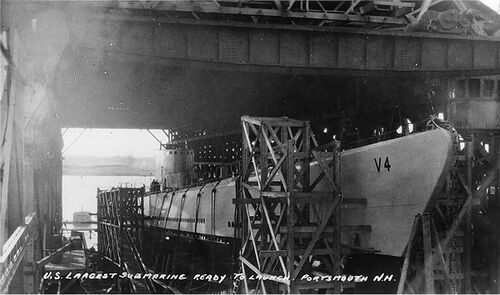
U.S. Navy photo
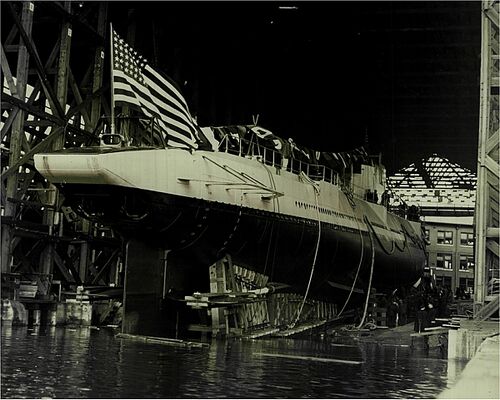
U.S. Navy photo
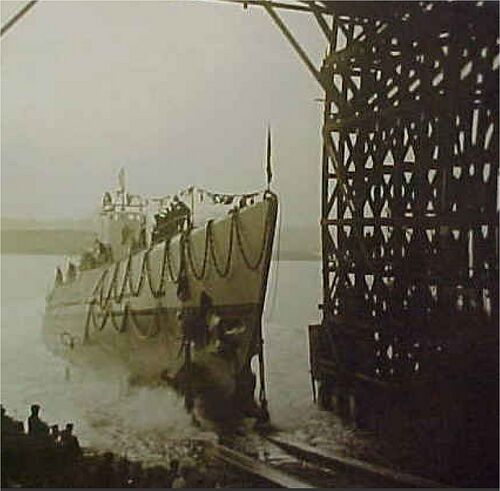
Photo courtesy of Navsource.org and the Boston Herald-Traveler
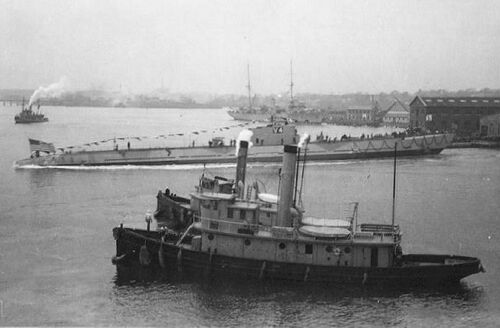
U.S. Navy photo
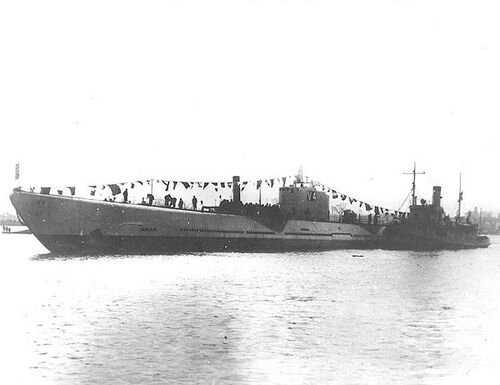
U.S. Navy photo
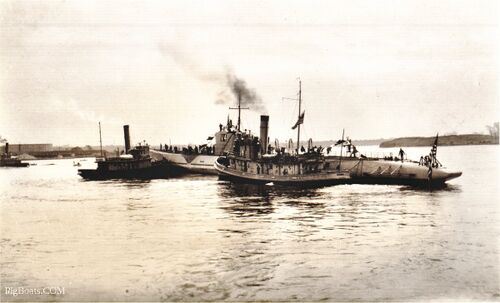
A number of interesting things are seen and happening in this photo. The launch is complete and the signal flags are coming down. The flags forward of the conning tower are being gathered up. The after string of flags is being loosened. A Bi-pod of boards supported the after string. A man has climbed to a cross brace to free them. A man stands behind him to steady him. A Chief or Officer is on the stern inspecting and ensuring that all is satisfactory.
The dark triangle seen between the tugs is the forward gun sponson. There is a similar one behind the conning tower hidden by the Mohave. The Mohave itself has just applied forward thrust to is propeller as evidenced by the wash seen at her stern. The white "splash" seen at the waterline at the side of Mohave is the outlet for the cooling water for the tugs' boiler.
The tug all the way to the left is taking charge of the building cradle seen floating next to it. A crew in a small boat is assisting.
Photo in the private collection of Ric Hedman
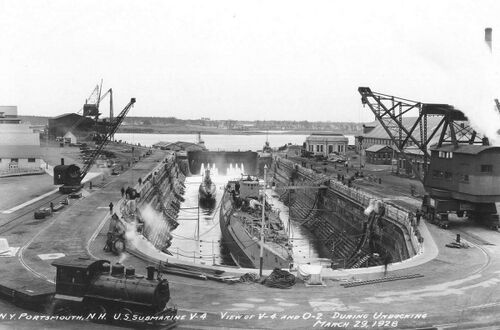
U.S. Navy photo
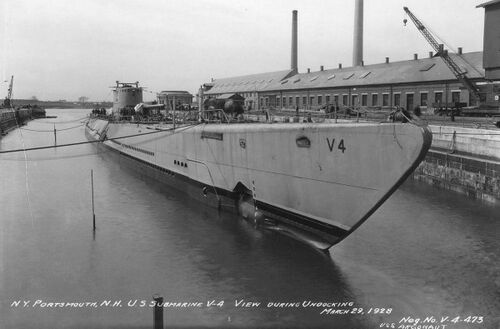
U.S. Navy photo

U.S. Navy photo
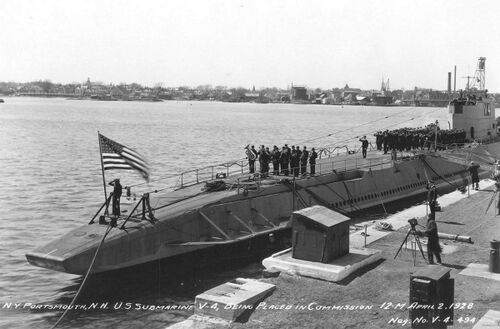
The notch in the edge of the deck on the starboard side was for a communications mast that would fold down into the notch. The mast is not yet installed in this photo. There is a similar notch for another mast in the edge of the deck forward of the forward deck gun.
U.S. Navy photo
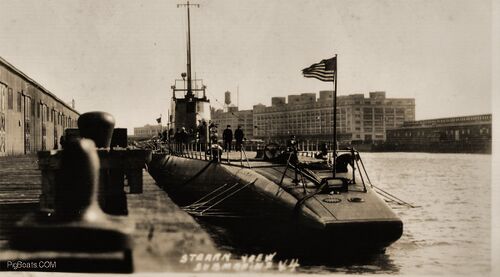
Photo in the private collection of Ric Hedman
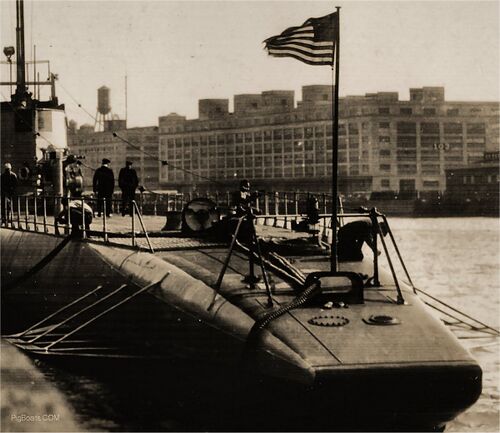
Photo in the private collection of Ric Hedman
Sea trials, June, 1928
V-4 making a dive likely sometime in 1928 during trials. The long low shoreline in the background indicates that this is Cape Cod Bay, Massachusetts. That would put this video in the same time frame as the rest of the photos in this section.
Video from the YouTube British Pathé channel.
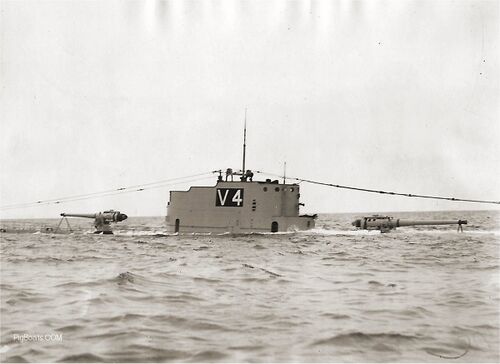
Her gun deck with her two 6"/53 caliber guns is just awash and the conning tower fairwater accesses are filling with water. The little splash of water seen just to the right of the forward fairwater access is coming from the ammunition hoist as it goes under water.
The short periscope at the front of the conning tower is the #1 periscope. It is offset to starboard by four feet off the center line (note its location in subsequent photos below) and is a short 'scope to be used before surfacing to check for obstacles. This periscope was later removed as unnecessary. The submarine had two centerline mounted regular periscopes that gave full visibility. These periscopes were all raised by electric motors and used a chain drive like a motorcycle type chain. They were very noisy. If you get a chance to see the 1931 movie "Seas Beneath" you can see and hear them in operation plus see some interior images of the submarine.
The ship's whistle can be seen sticking out at the front of the fairwater midway between the step and the top.
Photo in the private collection of Ric Hedman.
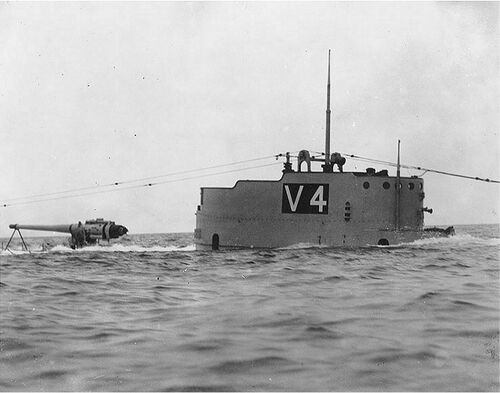
U.S. Navy photo
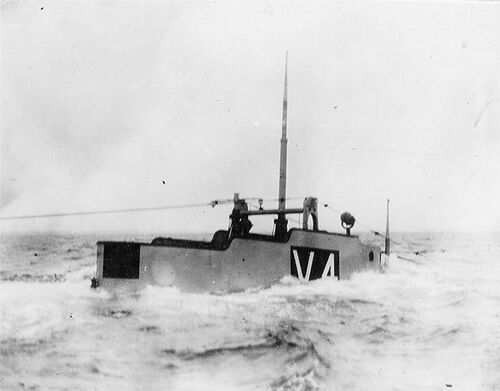
U.S. Navy photo

U.S. Navy photo

U.S. Navy photo
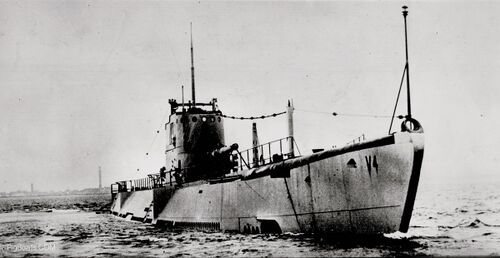
This photo was acquired from a German source and has a publication date of February 22, 1943. All notations are in German. That was four days before the Navy struck Argonaut's (V-4's) name from the Navy List as she had been sunk in action against the Japanese between New Britain and Bougainville, south of St. George's Channel on January 10, 1943.
Copy of a U.S. Navy photo acquired from a German WW II News Source in the Private Collection of Ric Hedman
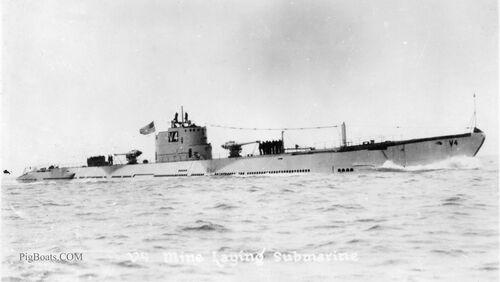
V-4 as viewed from starboard during her trials, June 1928. She is pushing through the Atlantic at speed, probably 12-15 knots. A portion of her crew is lined up on the forward and aft decks for this photo op. V-4 was a fine looking submarine indeed.
Photo in the private collection of David Johnston.
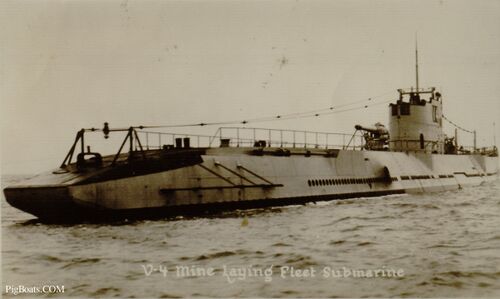
A starboard quarter view of V-4, likely taken during her June, 1928 sea trials. Large steel propeller guards jut out from her stern. These are intended to prevent damage to the propellers while maneuvering alongside a pier or while working with a tug. The recess in the top edge of her starboard side superstructure was for a fold down communications mast, which can be seen laying in the notch. V-4's two large minelaying tubes are just under the flat stern and out of view in this picture.
Photo in the private collection of Ric Hedman.
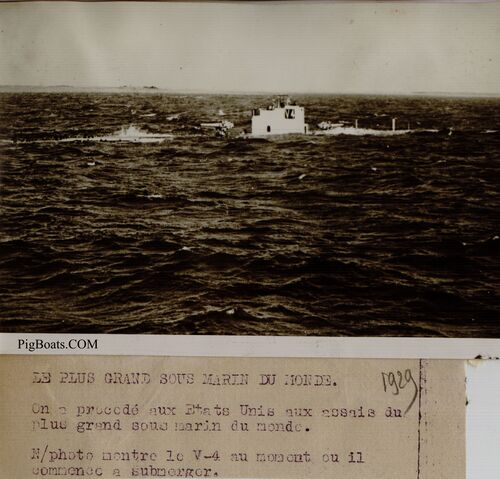
V-4 underway on trials, likely in the summer of 1928 in the waters off Cape Cod, MA. She is diving with her deck awash but with her guns and conning tower fairwater still above the surface. This photo was acquired by Ric Hedman and originally comes from a French newsreel service, even though it was likely taken by a USN photographer. The giant V-4 was making headlines around the world at the time and she was generating a lot of interest in international naval circles.
Photo in the private collection of Ric Hedman.
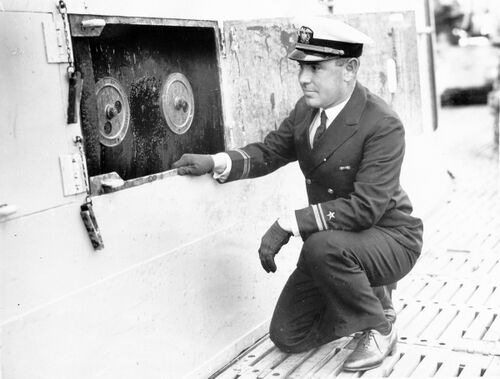
U.S. Navy photo
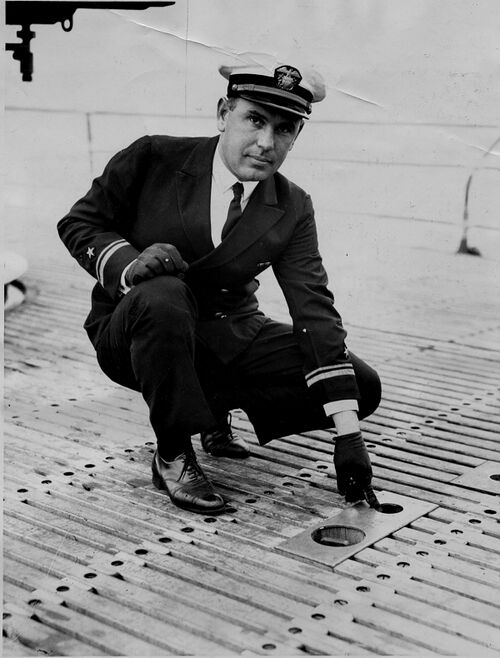
U.S. Navy photo
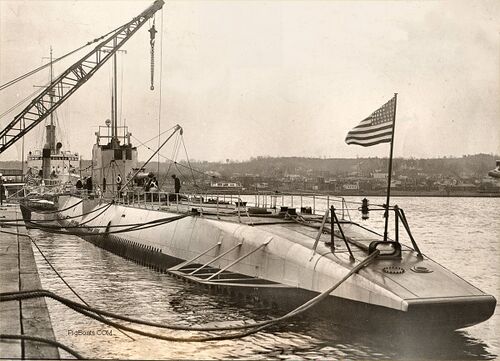
Just to the left of the door in the side of the fairwater is the after ammunition hoist. The shells for the guns were brought up from below this way. The shell and propellent powder bags were separate due to the weight involved. This made for easier and quicker handling.
the stern navigation light is mounted on the aft rail. The mooring lines are run through the after towing fairlead and lead to a set of bitts mounted on the aft deck.
Original News photo in the private collection of Ric Hedman.
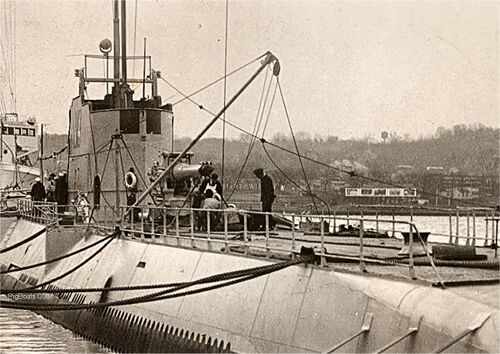
Original News photo in the private collection of Ric Hedman.
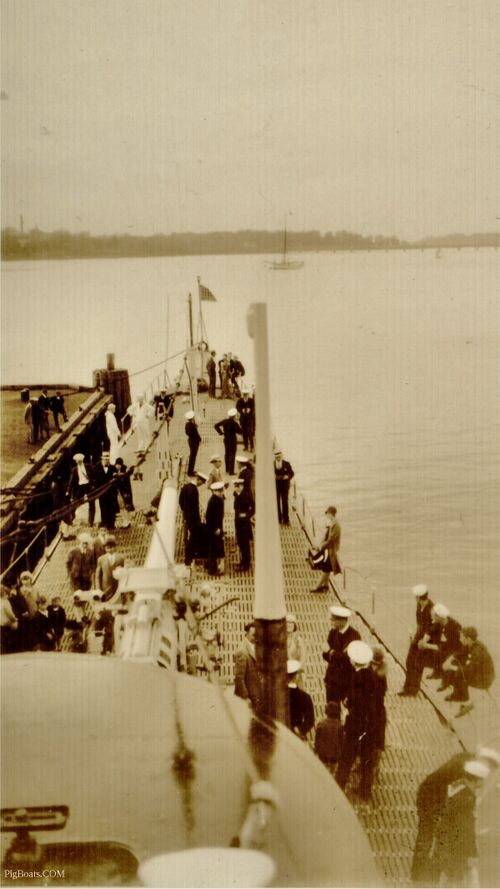
Original photo in the private collection of Ric Hedman
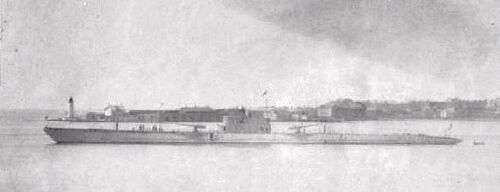
Photo in the private collection of Ric Hedman
Homeport shift to San Diego, 1929
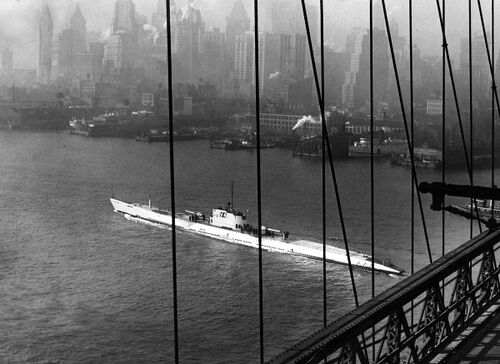
U.S. Navy photo
Video of V-4's departure from New York, 1929. In the view looking down from the bridge, details of the forward deck can be seen, including the two deck hatches covering her small boats. There is also a brief glimpse of the bridge and fairwater area.
Video from the YouTube British Pathé channel.

U.S. Navy photo
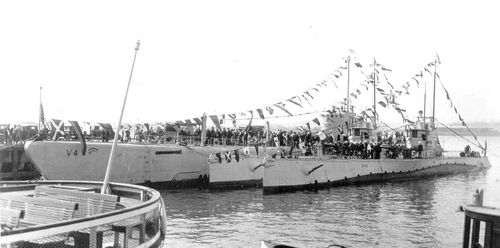
U.S. Navy photo
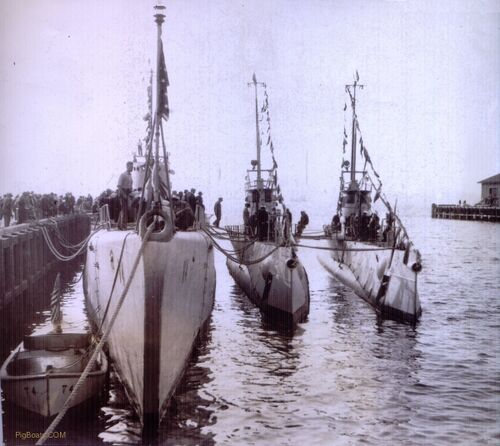
Seen in the lower left corner of the photo is one of the V-4's two launches. These were stored under the deck on the bow just aft of the forward torpedo room escape trunk. One was a rowing boat and the other a motorized launch. This is the motor launch.
Photo in the private collection of Ric Hedman
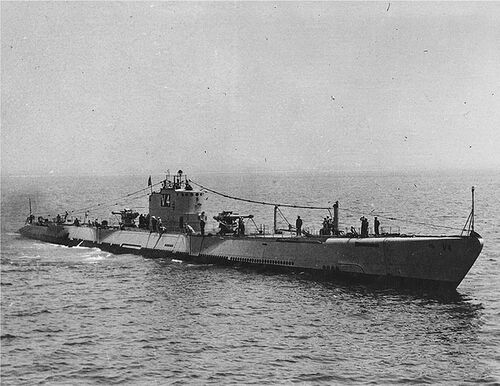
U.S. Navy photo
V-4 stars in the 1931 movie "The Seas Beneath"
PigBoats.COM has a 12 photo collection of stills and production shots from the movie. These came courtesy of Robert Morgan, and especially Mrs. Wendy Gulley of the Submarine Force Library & Museum in Groton, CT. All but one of the photos are from the personal collection of LCDR William Quigley, USN, the commanding officer of V-4 at the time, and may NOT be reused or reposted without the permission of the SFL&M.
Click here for this photo collection
1932 homeport shift to Pearl Harbor, Renaming, and World War II service
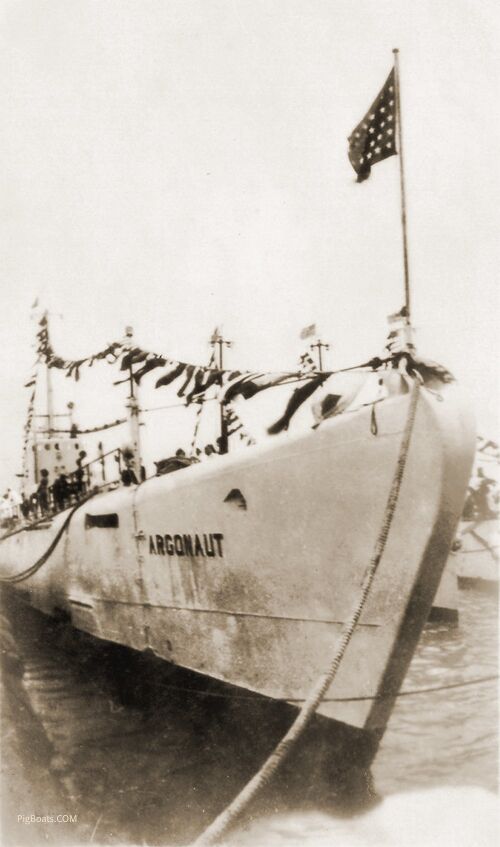
U.S. Navy photo
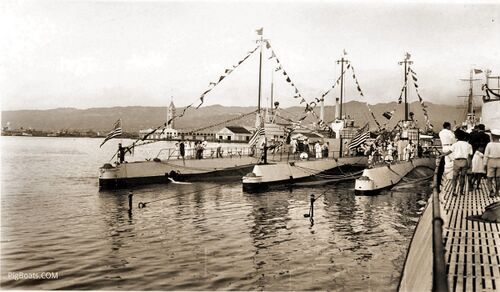
U.S. Navy photo
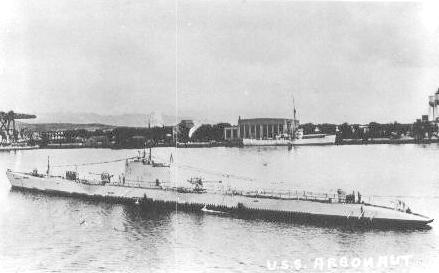
Photo in the private collection of Ric Hedman
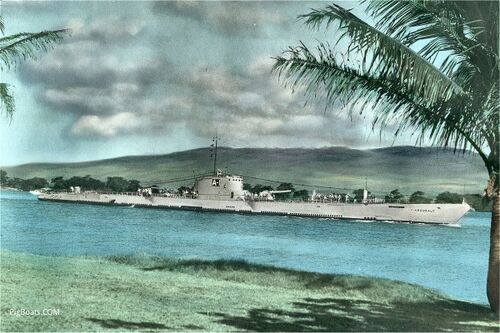
U.S. Navy photo
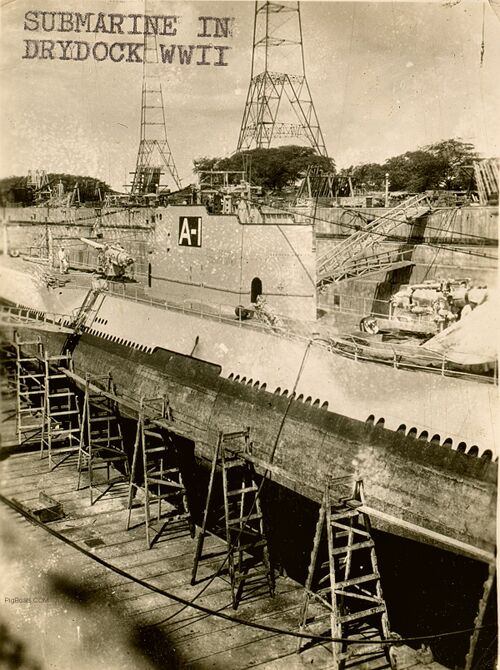
Photo in the private collection of Ric Hedman
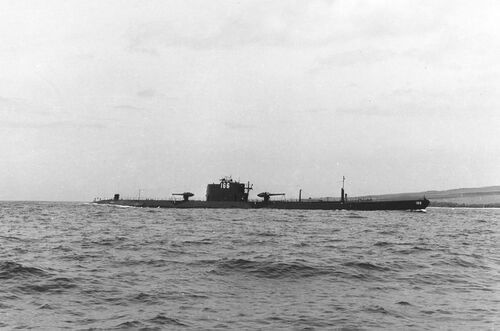
U.S. Navy photo courtesy Navsource.org

Photo from Life Magazine in the public domain.
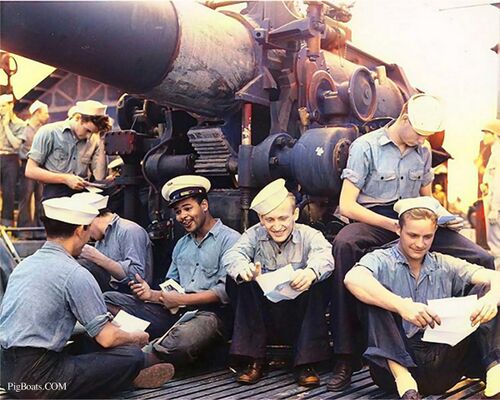
The African American Steward/Mess Attendant shown in this photo is Officer Steward 2nd Class Willie D. Thomas. He seems to have received a letter from home with a photo in it. Maybe of a wife or child. He appears to be talking with shipmate and fellow steward, Mess Attendant 1st Class Marcelino Taclob "Berg" Bergado. (back to camera)
The man seated in the center of the photo reading his letter with a big smile is Machinist's Mate 3rd Class William George Wehner from Mitchell, South Dakota. These were among those aboard the Argonaut when she was sunk on January 10, 1943. Rest in peace shipmates.
U.S. Navy photo now in the collections of the National Archives
Colorized by PigBoats.COM
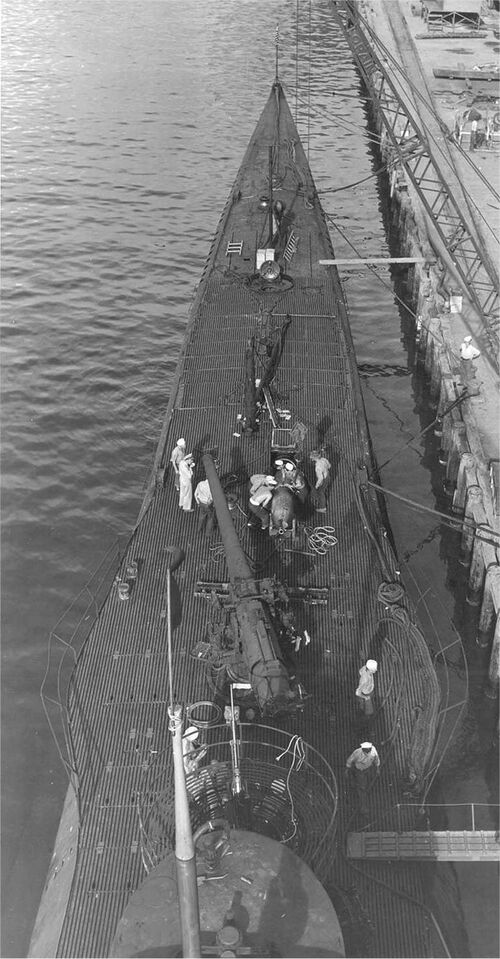
Please check out this page of Argonaut plans and blueprints. There you will see that her torpedo loading hatch was actually above the crew's mess space. Reload torpedoes would be winched down into this space, then laboriously moved forward into the torpedo room. It was also normal to stow at least two reload torpedoes on the starboard side of the crew's mess space.
U.S. Navy photo
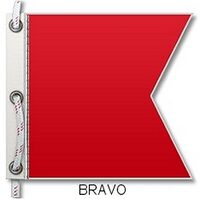
1943 World War II Loss
The following is from the Dictionary of American Naval Fighting Ships: " On 10 January 1943, Argonaut spotted a Japanese convoy of five freighters and their destroyer escorts. An Allied Army aircraft was by chance flying overhead and witnessed Argonaut's attack. (All the planes ammunition had been expended) Argonaut hit at least one of the destroyers with her torpedoes, and they promptly counterattacked. A crew member on board the plane saw Argonaut's bow suddenly break the water at an unusual angle. It was apparent that a depth charge had severely damaged the submarine. The enemy destroyers circling Argonaut fired shells into the boat from point blank range until she slipped below the waves. One hundred and five officers and men went down with the submarine. Her name was struck from the Navy list on 26 February 1943.
Argonaut was awarded two battle stars for her World War II service."'
The following are excerpts from the authoritative web page Combined Fleet (Nihon Kaigun). This site is maintained by Jon Parshall and Tony Tully, two highly respected historians and authorities on the IJN. On their Tabular Record of Movement (TROM) page for the destroyer Maikaze, we find the following entry concerning this action:
5-10 January (1943): IJN destroyer Maikaze TROM entry:
With Desdiv 17, escorted troop convoy (Operation 18: BRAZIL MARU, NICHIRYU MARU, CLYDE MARU, CHIFUKU MARU and MYOKO MARU, lifting units of 51st Division) from Rabaul to Lae and back. On 7-8 January NICHIRYU MARU and MYOKO MARU lost in bombing attacks. On 7 January rescued survivors of bombed transport NICHIRYU MARU; on 10 January sank USS ARGONAUT (APS-1) assisted by (destroyer) ISOKAZE and seaplane. Then to Shortlands on 13 January.
10 January (1943): IJN destroyer Isokaze TROM entry:
Action:
- 1025 A D3A of the 582nd Air Group reported a submerged submarine preparing to attack, and dropped three 60kg depth bombs. Destroyer MAIKAZE was led to it and dropped 95 depth-charges.
- 1045 The bow of the enemy submarine suddenly emerged from the sea. ISOKAZE joined MAIKAZE in shelling it till it sank. (This was a confirmed sinking and was USS ARGONAUT (APS-1) Convoy proceeded to Rabaul that same night.'
Argonaut was old, large, under powered, unwieldy submerged, and was unsuited for the type of action she was asked to perform. As a transport she performed well, but as an attack submarine she was totally unsuited for that final action. The U.S. command in Brisbane made the decision to send her out on this fateful patrol regardless.
Page created by:
Ric Hedman & David Johnston
1999 - 2023 - PigBoats.COM©
Mountlake Terrace, WA, Norfolk, VA
webmaster at pigboats dot com

